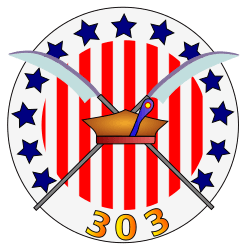303 Squadron facts for kids
Quick facts for kids 303 Squadron |
|
|---|---|

303 Squadron Honour Badge design
|
|
| Active | 2 August 1940 – 11 December 1946 |
| Country | |
| Allegiance | |
| Branch | |
| Role | Fighter Squadron |
| Part of | RAF Fighter Command |
| Nickname(s) | "Rafałki", "Kosciuszko Squadron" |
| Scarf colour | Scarlet |
| Anniversaries | 1 September Squadron holiday |
| Battle honours | Battle of Britain 1940, Fortress Europe 1941-1944, France and Germany 1944-1945 |
| Commanders | |
| Notable commanders |
R. G. Kellett John A. Kent Zdzisław Krasnodębski Witold Urbanowicz Jan Zumbach Witold Łokuciewski |
| Insignia | |
| Squadron Codes | RF (Aug 1940 – Apr 1945) PD (Apr 1945 – Dec 1946) |
| Aircraft flown | |
| Fighter | Hawker Hurricane Supermarine Spitfire Mustang IV |
No. 303 Squadron RAF (also known as Polish: 303 Dywizjon Myśliwski "Warszawski im. Tadeusza Kościuszki") was a very important group of fighter pilots during World War II. It was one of two Polish squadrons that fought in the famous Battle of Britain. This battle was a major air fight over Britain in 1940.
The squadron flew Hawker Hurricane planes. Even though they joined the battle two months late, they shot down more enemy aircraft than any of the other 66 Allied fighter squadrons. This made them true heroes of the sky. The squadron was formed in July 1940 in England and was officially part of the Royal Air Force (RAF). It was disbanded in December 1946 after the war ended.
Contents
No. 303 Squadron: Joining the Fight
No. 303 Squadron was created in July 1940 in Blackpool, England. This happened because the Polish Government in Exile and the United Kingdom made an agreement. Many Polish pilots had escaped from their home country after it was invaded. They wanted to continue fighting against the enemy.
On August 2, 1940, the squadron moved to RAF Northolt. This was an important air base near London. They quickly got ready to join the ongoing air battle.
Heroes of the Battle of Britain
The Battle of Britain was a huge air battle fought in the skies over Britain in 1940. The German air force, called the Luftwaffe, tried to destroy the RAF. If they succeeded, Germany planned to invade Britain.
No. 303 Squadron joined the fight in late August 1940. They flew fast and powerful Hawker Hurricane fighter planes. Their pilots were very skilled and brave. They quickly became known for their amazing success.
- They shot down the most enemy planes of any squadron in the battle.
- They were credited with destroying 126 German aircraft.
- Their success helped the RAF win the Battle of Britain. This stopped Germany from invading Britain.
A Special Polish Connection
The pilots of No. 303 Squadron were mostly Polish. They were fighting for their adopted home, Britain, and for the freedom of their own country. Their bravery showed the strong spirit of the Polish people.
The squadron was sometimes called "Kosciuszko Squadron." This name honored a Polish national hero, Tadeusz Kościuszko. He was a military leader who fought for freedom in the 18th century. The squadron's nickname showed their pride in their Polish heritage.
Squadron Legacy and Recognition
No. 303 Squadron had a fantastic combat record throughout World War II. They continued to fly different types of planes, like the Supermarine Spitfire and Mustang IV, in later parts of the war. They took part in many important operations.
The squadron was officially disbanded in December 1946. Their incredible story has been remembered in books and films. For example, the 2018 film Hurricane tells the story of their heroic actions during the Battle of Britain. Their courage and skill continue to inspire people today.
Images for kids
-
126 German aircraft or "Adolfs" were claimed as shot down by No. 303 Squadron pilots during the Battle of Britain. This is the score of "Adolfs" chalked onto a Hurricane.



